Past Projects
Energy Retrofits
City facilities are receiving upgrades to energy efficient and water conservation technologies due to a $2.6 million Energy Efficient Conservation Block Grant provided by the U.S. Department of Energy. About 3 million kilowatt-hours annually will be saved when the projects are completed 2013. Partial list follows:
HVAC Retrofit Projects at Nine (9) City Buildings (2012-2014)
The City's Facilities Services Division staff completed energy efficiency HVAC retrofits in 2013 and 2014 at seven (7) buildings including: Beckwourth/Mountain View, Benjamin/Allied Gardens, and Malcolm X libraries; Eastern Police Station; and Fire Stations 11, 20, and 40. These projects were a result of 2012 energy audits completed by Environmental Services. In addition Facilities and Environmental Services coordinated and added two (2) facility HVAC projects at the San Ysidro Library and Montgomery Field Airport Administration Building that were not audited but were coordinated for efficient unit replacements. In each case, the City’s HVAC shop installed high efficiency HVAC units and equipment. The projects qualified for San Diego Gas & Electric (SDGE) rebates, with a majority of the audited project expenses paid for by an American Recovery and Reinvestment Act (ARRA) grant. The City will save approximately 200,000 kWh of energy and $40,000 annually as a result of these efforts.
City Administration Building Complex Boiler Upgrades
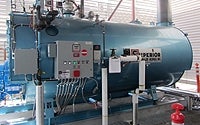
Boiler replacement at City Administration Building (CAB) upgraded the two existing 250 hp and 50 hp steam boilers, controls and associated equipment. The boilers were replaced with three boilers (250 hp, 150 hp, 50 hp). The project provides higher efficiency equipment replacements throughout the five buildings served: CAB, Golden Hall, Civic Theatre, City Operations Building, and Fire Station 1. The steam boilers provide steam, heating and hot water to the facilities. Savings will result from lower gas, electric, and water usage. Completed June 2012.
City Gym Lighting Improvements
Gyms at 26 city Park and Recreation centers are receiving energy efficient fluorescent lighting to brighten the playing area to be more like daylight. Upgrades include new ballasts, control wiring and switching. Energy rebates are anticipated. Completed July 2012.
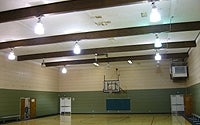
Before-Mira Mesa Rec Center
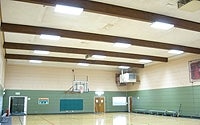
After-Mira Mesa Rec Center
Citywide Broad Spectrum Street Lighting Retrofits
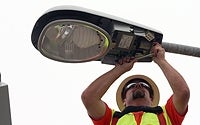
About 36,000 energy-efficient, broad-spectrum induction street lights replaced sodium-vapor lights in a citywide that was completed 2013. The new induction lamps provide a better color rendering than the current sodium-vapor lamps, which cast a yellow glow. The $16 million street light replacement project was funded by bonds and low-interest loans at a reduced cost to city taxpayers. Learn more about the Citywide Broad Spectrum Street Lighting Retrofits.
Previous Energy Saving Projects
Ridgehaven "Green Building"
The Ridgehaven "Green Building" is one of the nation’s most energy-efficient buildings. In 1999, Ridgehaven was honored with the U.S. Department of Energy and the U.S. Environmental Protection Agency's (EPA) first Energy Star Label for Buildings. In 2002 the EPA recognized Ridgehaven as one of the top energy performing buildings in the nation. Along with two other facilities --the Miramar Operations Center and the Carmel Mountain Library-- Ridgehaven has been accepted by the U.S. Green Building Council (USGBC) to participate in its Leadership in Energy and Environmental Design Existing Building Pilot Program (LEED-EB). Since 2003, all new City facilities and major remodels over 5,000 square feet are evaluated for LEED’s "silver" star level certification.
Operations Center Administration Building is San Diego's Most Energy-Efficient Municipal Building
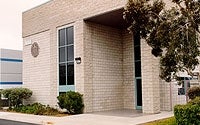
Photovoltaics, a "green" retrofit to the administration building, and operational efficiencies make ESDs Operations Center the City's most environmentally-friendly and efficient building.
The facility was purchased in 1998 from Waste Management, Inc. to centralize and combine the functions of four separate facilities located throughout the city. The main role of the station is providing vehicle servicing and fueling for ESDs refuse and recycling collection packers. Energy-efficient technologies were incorporated into the administration building before ESDs Collection Services Division moved to this new location in 2001.
These upgrades include installation of a heat-reflecting "cool roof" and heat-reducing window awnings, a high-efficiency air conditioning system with programmable thermostats, and energy-saving T8 fluorescent lighting fixtures that feature daylight and occupancy sensors, and efficient electronic ballasts. Building materials such as doors were reused or recycled during the retrofit, which helped divert waste from entering the Miramar Landfill.
These upgrades helped increase the energy efficiency by 38 percent. More than 80,000 kilowatt-hours are saved annually and about 45 tons of carbon dioxide and other greenhouse gases are diverted from the atmosphere. These savings produced an annual cost avoidance of more than $14,000.
The refuse and recycling collection packers are equipped with a Geographical Information System (GIS) using RouteSmart software, which saves 23,000 miles a year, or nearly 10,000 gallons of fuel by optimized routing of collection vehicles. This clean air savings translates to 107 tons of carbon dioxide diverted from the atmosphere. Further savings are anticipated as the entire city is remapped from the centrally located Operations Center.
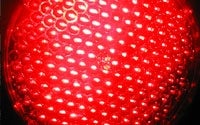
90 Percent of City Traffic Lights Upgraded to Efficient Light Emitting Diodes
The City has completed upgrading almost 90 percent of the City's 1,486 signaled intersections to energy-efficient light emitting diode (LED) lamps. The Street Division installed the LEDs, which replaced incandescent lights. Each year, these LEDs reduce energy use by 13,212 megawatt-hours, eliminate 7,437 tons of greenhouse gases, and save the City $1.3 million. The San Diego Gas & Electric rebate program, which ended in 2002, provided $1.4 million since 1997 to pay for 30,415 of the LEDs.

Four City Facilities Now More Energy Efficient
The City avoids more than $250,000 in energy costs each year after the Central Library, World Trade Center, Pump Station #2 and the Crabtree Building received retrofits of energy-efficient equipment. A 12-month performance analysis by Onsite Energy Corporation shows that energy usage in 2001 for the four buildings dropped after the energy conservation upgrades. The report was authored by Onsite, who performed the retrofits. Examples of the many energy-conservation measures to these buildings include:
- A lighting retrofit at the Crabtree Building and Metropolitan Wastewater Department's Pump Station #2.
- A large ventilation fan and filter installed in Pump Station #2.
- Variable speed drives on pumps and motors and high-efficiency water chillers for the air conditioners installed in the Central Library and World Trade Center.
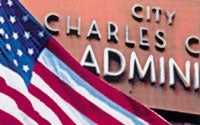
Energy Savings Retrofit of City Complex Exceeds Anticipated Savings by $200,000
- Lighting upgrades to install T-5 lamps in 75 libraries and Park and Recreation facilities save 50% of the energy used by the old T-12 lamps.
- Savings from electricity and gas usage resulted from comprehensive mechanical and lighting retrofits.
- The five buildings include: City Hall, City Operations Building, Convention Center, Plaza Hall, and Civic Theatre.
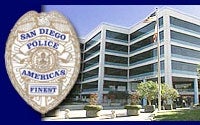
Savings Pay for Energy Updates to San Diego Police Headquarters
The energy-efficiency updates to the Police Headquarters are financed by annual savings from the building's increased efficiency. The system – the first in California – features a unique "hybrid" design that interconnects a 510-kilowatt cogeneration system and a 30 kilowatt (AC) photovoltaic array to a single meter.
Cogeneration
Self Generation of Electricity and Heat at Wastewater Treatment Plants
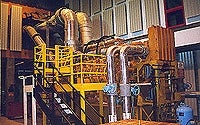
Methane gas, a renewable resource, runs engines that produce electricity while thermal energy generated by electrical power provides heat and cooling for three Public Utilities Department buildings: the Point Loma Wastewater Treatment Plant, the North City Water Reclamation Plant, and the South Bay Water Reclamation Plant.
Independently Powered Community of Tomorrow (IPCOT)
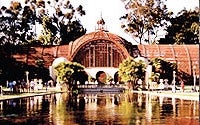
In May of 2002, the City along with the Department of Energy will explore opportunities relating to utilization of landfill gas from the Arizona Landfill to generate power for the facilities in Balboa Park. This proposal will explore several different technologies including cogeneration, micro-turbines, and photovoltaics. This project will serve as a pilot for the first energy independent community and is a giant step toward achieving the City's goal of energy independence through self-reliance.

